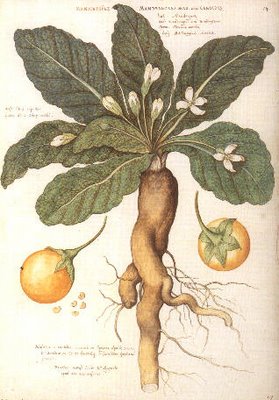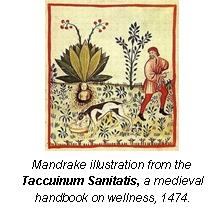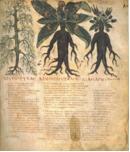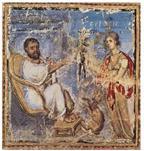 Mandragora or Mandrake
Mandragora or Mandrakeby Laura Diaz-Arnesto
During their extended and fruitful existence, is obvious to believe the Byzantine Empire had herbalists and physicians that not just adopted (copied), but adapted and discovered numerous drugs and preparations for the treatment of pain and other illnesses, including those containing the somehow mystical, and highly toxic, mandragora root.

The earliest surviving illustrated surgical codex was made for the Byzantine physician Niketas about 900 CE

“Give me to drink mandragora…
That I might sleep out this great gap of time
My Antony is away.” (Shakespeare’s Antony and Cleopatra, I.v).
“Shrieks like mandrakes’ torn out of the earth.”
(Shakespeare’s Romeo and Juliet, IV.iii)
Byzantine herbalists and physicians surely came to know analgesic,
sedative and anaesthetic preparations containing mandrake. However, as
we know so little about this magnificent people, we need to wait for
scholars to go through medical-historical Byzantine texts to confirm the
extent of the aforementioned affirmation. As Prof John Scarborough
from the University of Wisconsin so clearly states it: “Byzantine
medicine: a millennium of medical history, very poorly known by
comparison with ‘classical’ Arabic or Greco-Roman medicine”. Moreover,
in his Byzantine Medicine & Pharmacy course information of Spring
2008, he tells students: “Even today, some 25 years after I composed the
“Introduction” to the 1984 Dumbarton Oaks Papers, the ‘state of
research’ remains much the same, with basic texts and sources unedited,
given eras of Byzantine medicine still unexplored, and too few qualified
philologists, physicians, and historians have devoted efforts to
understanding the medical history of the Byzantine Empire. I recommend
reading his various articles and booksIn what could be called the precursor of modern pharmacopeia, the Greek herbal De Materia Medica by Pedanius Dioscorides of Anazarba in Cilicia, the author describes the mandragora in detail, and explains how wine made from mandragora can induce anaesthesia – in the sense of an absence of sensation – in people about to undergo surgery or a cauterization of their wounds.
“… [sleeping potions such as opium or mandragora are applied] to such [people] as shall be cut, or cauterised … For they do not apprehend the pain because they are overborn [overcome] with dead sleep …. But used too m much they make men speechless.” Pedanius Dioscorides
This seminal book written in the first century AD was faithfully studied, copied and quoted for another fifteen hundred years, mainly by Byzantine scribes. One of its more famous copies known as the Vienna Dioscorides can be found in the Austrian National Library; and mandrake is present in two paintings of the frontispiece of this illustrated manuscript completed in 512 CE (also known as the Aniciae Julianae Codex). More than 600 plants and 1000 drugs were described in this ancient pharmacopeia, which remained the standard medical text until the 17th century.
More recent studies described evidence on pain relief and sedation for surgical and medical purposes traced in literary medical treatises from the Roman and Byzantine times (2nd century BC to 7th AD). Roman and Byzantine scientists, such as Dioscorides Pedanios, Gaius Plinius Secundus, Galen, Orivasios from Pergamum, Themistios, Aetios of Amida, Ioannes Damascenos and others, referred to Mandragora officinarum, Hyoscyamos niger and Atropa belladonna as the most important herbs, besides the opium poppy, to be used for producing pain relief and sedation.
Many other drugs and herbs were extensively used by Byzantine physicians, contributing in this way to the preservation and deepening of ancient pharmacological knowledge.
Laura Diaz-Arnesto
Montevideo – Uruguay
References
- Goodman & Gilman’s “The Pharmacological Basis for Therapeutics”, 6th Edition.- Rätsch C., Encyclopedia of Psychoactive Plants, Park Street Press, 2005, pg. 796-7.
- John Scarborough, Early Byzantine Pharmacology, Dumbarton Oaks Papers, Vol. 38, Symposium on Byzantine Medicine, (1984), pp. 213-232
- Ioanna A. Ramoutsaki, Helen Askitopoulou, and Eleni Konsolaki, Pain relief and sedation in Roman Byzantine texts: Mandragoras officinarum, Hyoscyamos niger and Atropa belladonna, International Congress Series, Volume 1242, 2002, pg. 43-50.








No comments:
Post a Comment